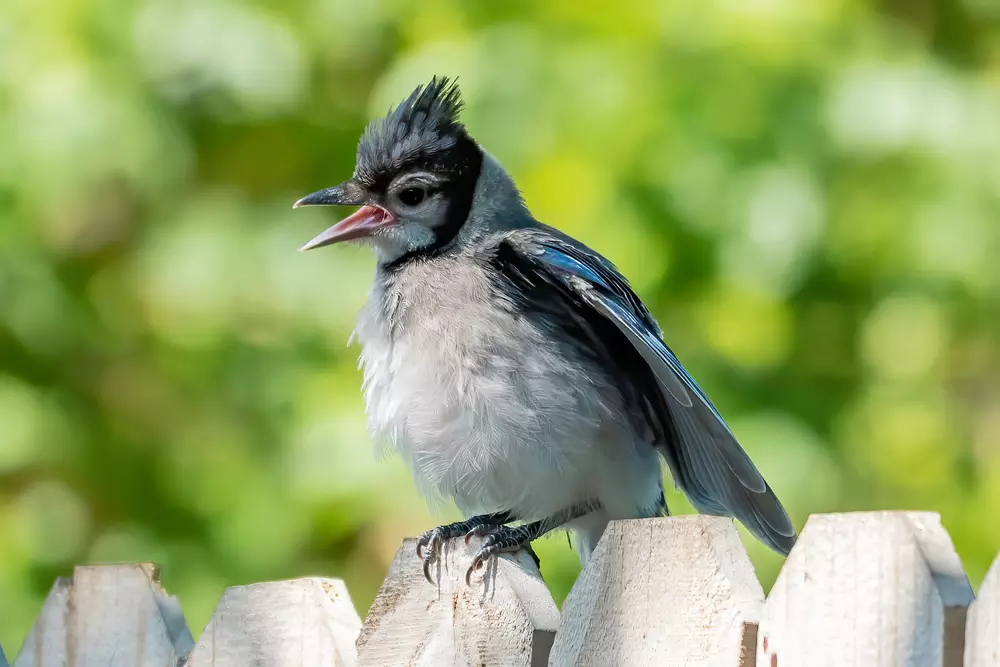The Blue Jay, a vibrant, intelligent bird, is common across North America. Its distinct coloring and behavior make it a fascinating creature, particularly when it’s a baby. The care of a baby Blue Jay may sometimes fall upon us, due to natural circumstances like storms, high winds, or unfortunate events leaving the bird separated from its parents.
Blue Jays, known for their striking blue, white, and black plumage, are omnivores, having a diverse diet from nuts to insects. Babies, however, require specific nutrition for healthy growth, which is where informed feeding practices come into play.
The knowledge of feeding a baby Blue Jay properly can lead to its survival and eventual return to the wild. Proper care, which includes feeding, contributes to the preservation of this species, adding to the biodiversity of our environment.
Assessing the Situation
Determining if the Baby Blue Jay Needs Help
Before we intervene, it’s essential to assess the situation carefully. A baby bird on the ground isn’t always in distress or abandoned. Often, these fledglings are learning to fly, with their parents watching nearby. Look for signs of injury or prolonged abandonment before deciding to step in.
Interacting with Baby Blue Jays: Do’s and Don’ts
The misconception that human scent will deter parent birds isn’t true. However, frequent human interaction might cause unnecessary stress to the baby bird. Keep handling to a minimum, and always wash your hands before and after to prevent disease transmission.
Feeding Baby Blue Jays: The Basics
Dietary Needs of Baby Blue Jays
A baby Blue Jay’s diet is significantly different from that of an adult. Their meals usually consist of protein-rich foods for optimum growth. A mixture of boiled eggs, mealworms, and wet dog food can substitute their natural diet.
Identifying Suitable Foods
When preparing food, it should be appropriately sized to prevent choking. The consistency needs to be soft, but not runny, and warm, not hot, to suit the baby bird’s palate and digestion.
Unsafe Foods: What to Avoid
Bread, milk, and birdseed are unsuitable for baby birds as they lack the necessary nutrients. Additionally, they may lead to digestive issues. Always stick to foods that align closely with a baby bird’s natural diet.

How to Feed a Baby Blue Jay
Preparing the Food
Preparing the food involves finely chopping or mashing the ingredients. The mixture should be moist but not liquid. Overly soggy food might lead to aspiration, while too dry might lead to dehydration.
Techniques for Feeding
Feeding baby birds require patience and gentle handling. Use a pair of blunt-ended tweezers to offer food, and aim for the back of the throat to stimulate swallowing. Never force-feed, as it could lead to injuries or distress.
Frequency and Amount of Feeding
Feeding should happen every 15 to 20 minutes from dawn till dusk for the first week, gradually reducing the frequency as they grow. A baby bird’s tummy is tiny, so each feed should only consist of small amounts.
Observing Health and Growth
Signs of Healthy Growth
A healthy baby Blue Jay will steadily gain weight, develop feathers, and gradually start hopping and attempting to fly. Their eyes should be clear, and they should be alert and responsive.
Common Health Issues in Baby Blue Jays
Some common health issues include dehydration, stunted growth, and weakness. These can often result from inadequate diet or care. If you notice these symptoms, contact a wildlife rehabilitator immediately.
Post-Feeding Care
Cleanliness and Hygiene after Feeding
Keeping the bird and its surroundings clean helps prevent diseases. Clean any leftover food from the bird’s mouth and ensure its living area is hygienic.
Setting up a Safe Space for the Baby Blue Jay
A safe space is crucial for the baby bird’s growth. It should mimic natural surroundings as closely as possible and be safe from predators, including pets.
When to Contact a Wildlife Rehabilitator
Indications for Professional Help
If the bird appears injured, sick, or if you feel unsure about its care, seek professional help. It’s always better to err on the side of caution when dealing with wildlife.
Finding Local Wildlife Rehabilitators
There are numerous organizations dedicated to wildlife rehabilitation. Searching online or contacting local animal control can help you find a qualified wildlife rehabilitator near you.
Frequently Asked Questions
Can I keep a baby Blue Jay as a pet?
No, it’s illegal and unethical to keep a baby Blue Jay as a pet. The goal should be to help the bird return to its natural habitat.
Can baby Blue Jays drink water?
Yes, but they usually get their hydration from the food. However, care must be taken while giving water to avoid aspiration.
How long does it take for a baby Blue Jay to fly?
Typically, it takes about 3 weeks for a baby Blue Jay to start flying after they have left the nest or hatched.
Conclusion
Feeding a baby Blue Jay, or any wild bird for that matter, is not a casual commitment. It requires knowledge, dedication, and time to ensure their healthy growth and eventual return to the wild.
Being able to successfully care for a baby Blue Jay is a rewarding experience. It is not just about feeding them; it involves understanding their behavior, ensuring their health, and eventually letting them return to their natural habitat, where they truly belong.
Finally, it’s essential to remember that the ultimate goal of feeding and caring for a baby Blue Jay is to release it back into the wild. Every effort we make contributes to preserving wildlife, and every life saved enriches our environment and deepens our understanding of these remarkable creatures.